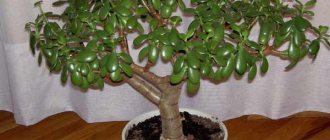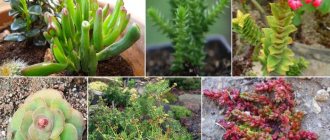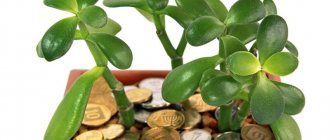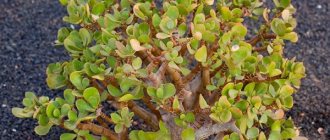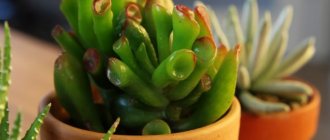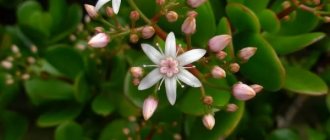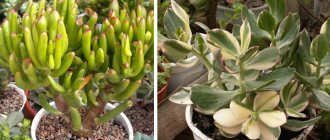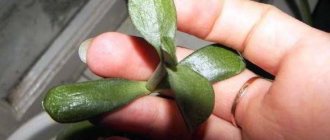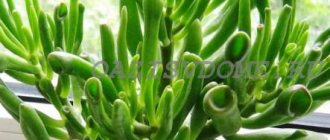Author: Elena N. https://floristics.info/ru/index.php?option=com_contact&view=contact&id=19 Category: Houseplants Published: January 26, 2019Last edits: January 11, 2021
- Growing from seeds
- Crassula ovata
plant (lat. Crassula) , or Crassula, is a representative of the genus of succulent plants of the Crassula family, which according to various sources includes from 300 to 500 species. More than two hundred of them grow in South Africa, many in tropical Africa and Madagascar, some species are found in the south of the Arabian Peninsula - Crassulas are distributed mainly in the Southern Hemisphere. The name of the genus comes from the word "crassus", translated meaning "thick", which in most cases is the fleshy structure of the leaves of many members of the genus. In indoor floriculture, Crassula flowers are known as “money tree” or “tree of happiness,” although it would be correct to call this species Crassula purslane. There are other representatives of Crassula in home floriculture, but first things first.
Planting and caring for crassula
- Flowering: the plant is grown as an ornamental foliage plant.
- Lighting: bright sunlight, bright diffused light or partial shade (southern, eastern and southwestern window sills).
- Temperature: in summer – normal for residential premises, in winter – 10-15 ˚C.
- Watering: after the substrate has dried to a depth of 2-3 cm.
- Air humidity: does not matter.
- Feeding: during the period of active growth, once a month with a fertilizer solution for cacti and succulents. In autumn and winter, fertilizing is not applied.
- Rest period: not clearly expressed, but rest in winter is desirable.
- Replanting: at least once every two years, in the spring, at the very beginning of active growth.
- Reproduction: cuttings, less often seeds.
- Pests: mealybugs and rootbugs, scale insects, spider mites.
- Diseases: gray rot, root rot, trunk rot, late blight.
- Properties: releases substances into the air that have antifungal, antiviral and antibacterial effects. The juice of the plant is used externally in folk medicine in the same cases and with the same results as aloe juice, but the juice cannot be taken internally because it contains arsenic .
Read more about growing Crassula below.
Botanical description
Both in nature and in culture, among Crassula there are tree-like shrubs, aquatic and even herbaceous plants, there are giants and tiny succulents, but they are united by one common feature: their leaves are located crosswise on the stem opposite each other. The Crassula succulent at home, of course, does not reach the same size as in nature, because the indoor Crassula plant is limited by space, the amount of soil, and other conditions necessary for intensive growth, but, nevertheless, the home Crassula gradually grows over time turns into a tree with a thick stem. The leaves are simple, entire, and in some species ciliated. The Crassula tree blooms with white, yellow, bluish or red flowers, collected in terminal or lateral umbellate-paniculate or racemose inflorescences, but at home, a blooming Crassula is a rare sight. The Crassula flower has gained popularity due to its hardiness, unpretentiousness and ease of care.
What plants are similar to Crassula perforata?
- Graptopetalum paraguayense (Paraguayan Graptopetalum) - like Crassula Perforata, has diamond-shaped, fleshy and green leaves.
- Aichryson x domesticum (Aichryson home) - similar in leaves, size of the formed bushes, as well as a hybrid variety.
- Monanthes muralis (Monanthes wall) - succulent, green leaves, about 3 cm in length.
- Monanthes amydros (Monanthes amydros) - racemose inflorescences, evergreen leaves.
- Graptopetalum paraguayense (Paraguayan graptopetalum) - the leaves are covered with bluish wax, has a short and succulent stem.
Caring for a fat woman is not difficult. If you follow all the rules, then this plant will give you good growth, a beautiful appearance, and will also bring a lot of joy and decorate any interior. We invite you to learn how to grow such types of Crassula as Tree, Pursula, Sunset, Moss, Silver, Buddha Temple, Ovata, Hobbit and Gollum.
In conclusion, it is worth noting that in addition to its unusual appearance, unpretentiousness, longevity and ease of care, Crassula is widely used in medicine as an antimicrobial and antiviral agent.
Caring for Crassula at home
Growing conditions
Most Crassula will not be harmed by direct sunlight, so you can easily place the pot with the plant on a south-facing window, although the best place for Crassula is the window sill of a window facing southwest or east. Lack of light negatively affects the decorative appearance of Crassula - the shoots become elongated and the leaves fall off. If you have the opportunity to keep Crassula outdoors in the summer - on a balcony or terrace - this will benefit the plant.
Crassulas are heat-loving, so they tolerate the summer heat normally, and in winter they do not suffer from proximity to working heaters as much as other plants, at the same time they feel great in winter and in cool rooms at a temperature of 10-15 ºC. Low air humidity is also not a problem for Crassula.
- Calamus (Acorus) – care, photos, types
In fact, constant care for Crassula only includes not very frequent watering of the plant, washing the leaves and fertilizing. How to water Crassula, which, as has already been mentioned more than once, is a succulent? How often should I do this? In summer, moisten the plant only after the top layer of soil has dried; in winter, let the soil dry 2-3 cm deep. Crassula is much more afraid of waterlogging than drought, so it will calmly tolerate your departure on summer vacation for 3-4 weeks.
Crassula is fertilized in the spring and summer once a month with liquid fertilizer for succulents and cacti; in autumn and winter the plant does not need feeding.
Formation
The formation of a tree must begin when the plant is still young, since when an already mature tree is formed, stumps remain at the site where the leaves are removed and the shoots are cut off, which affects the decorative quality of the Crassula. The first step is to choose the right pot for the plant: the Crassula root in a too large vessel tends to go deeper, and the Crassula itself tends upward, causing the trunk to stretch out, becoming weak and thin, so the pot for Crassula needs to be small and, most importantly, shallow.
As for the composition of the soil, the soil for Crassula should contain three parts of turf soil, one part each of humus soil, leaf soil, sand and fine gravel or brick chips. When the Crassula reaches a height of 15 cm, pinch off the two smallest top leaves - branching should begin at this point, that is, instead of two, two pairs of leaves should appear. As the Crassula grows, remove the top leaves in places where you think the shoots should branch - this will form the crown of your money tree.
Transfer
Crassula is replanted as needed, when the roots fill the entire pot, not necessarily annually, but if you want to see Crassula bloom, then replant it at least once every two years. It is better to do this in the spring, at the beginning of active growth.
How should Crassula be replanted? Take a slightly larger pot than the previous one, put a decent layer of drainage material in it - expanded clay or crushed shards, then transfer the Crassula from the old pot to a new one with a lump of earth and add as much fresh substrate as needed to fill the voids. If the Crassula root has become too long, shorten it before replanting to fit in the new pot. If you want to maintain the compact size of Crassula, try to avoid replanting the plant altogether, annually replacing only the top layer of substrate in the pot.
Properties of Crassula
Crassula is the guardian of your health: it releases substances into the air that have strong antibacterial, antiviral and antifungal effects. In addition, the juice of Crassula leaves, like aloe juice, is used in folk medicine in the form of lotions to treat herpes, bee and wasp stings, as well as for bruises, cuts and abscesses; as a rinse for the treatment of sore throat and gum inflammation; as a rub at night for arthritis. However, it should be remembered that Crassula juice should not be taken orally, since it contains arsenic in high concentrations.
It is believed that Crassula brings good luck in business and prosperity to the home, which is why, and also because of its ease of care, Crassula can often be seen not only in apartments, but also in the offices of trading companies and stores.
How and under what conditions does the money tree bloom?
The money tree blooms when it feels comfortable. Few people get to see this beauty. But even if the plant has never even formed buds, this does not mean that flowering will not happen: it should be provided with the right conditions and care.
Flower growers recommend that at the beginning of summer, take the pot outside and water it moderately: this way the plant will be in conditions close to natural. Keep it outside until it gets cold: low air temperatures stimulate the formation of buds. Then it is recommended to keep the flower in a cold room (about 15 °C), watering it once a week. So you can count on buds forming by November. They will bloom in December: these will be small flowers collected in inflorescences. The flowering period lasts approximately a month.
We also recommend reading:
16 most popular indoor plants Physalis: description of species and varieties, technology for growing from seeds Spruce in landscape design: the best ornamental varieties and characteristics of cultivation Kalanchoe: description of types and characteristics of care at home
Some types of Crassula bloom in summer.
Flower growers recommend taking the pot outside at the beginning of summer and watering it moderately.
Crassula propagation
Growing from seeds
Crassula seeds are sown in wide bowls with soil of the following composition: leaf soil - 1 part, sand 0.5 parts. The bowls are covered with glass, which is removed daily to remove condensation and ventilate the crops. Seeds germinate in two weeks. Slightly grown seedlings dive at a distance of 1 cm from each other into a container with soil from one part of leaf soil and half of sand and light turf soil. Keep picked seedlings under bright diffused light.
Strengthened and grown Crassulas are planted in pots 5-7 cm in diameter in soil consisting of leaf, turf soil and sand in equal parts, and kept for the first time until they take root, at a temperature of 16-18 ºC, and then transferred to a permanent place .
Crassula cuttings
If you are thinking about how best to propagate Crassula, then, of course, the method of propagation by cuttings is both more reliable and simpler than seed propagation. How to root Crassula and which parts of the plant are suitable for cuttings? Both stem segments and leaves are suitable for this method of propagation. A large shoot or large leaf is cut with a sharp knife, treated with crushed coal, dried for two to three days and planted for rooting in a mixture of sand and leaf soil. You can root cuttings in water with the addition of charcoal.
When the cuttings have roots, they are planted in pots 5-7 cm in diameter in soil made of leaf, turf soil and sand in equal proportions, placed in a permanent place and cared for as an adult plant.
Transfer
Young flowers are replanted every year. Adult bushes are planted less frequently, as the root grows, when the pot becomes small - 1 r. at 3 years old.
It is better to replant in the spring. The transfer method is used - the earthen lump is preserved, the plant is transferred to a container 2 cm larger than the previous one. The soil is renewed.
When replanting, infected and dry shoots are cut out , and root shoots that are too long are trimmed.
The sections are processed with crushed charcoal. The pots used are small and shallow, according to the size of the root.
Reference! If the flower has not grown too much, you can only update the top layer of soil.
Pests and diseases
The worst thing for Crassula is excess moisture, which can cause rotting of the roots and even the base of the trunk, because Crassula is one of those flowers that it is better to forget to water than to water twice. Drafts also pose a danger to Crassula - the plant gets cold, its leaves dry out and fall off.
- Names and photos of asparagus
Of the insects, mealybugs can cause harm to Crassula - they are removed from the leaves with a cotton swab soaked in medical alcohol. Sometimes scale insects appear on the plant, in which case you will have to treat the Crassula with Actellik. If you do not water the plant for a long time, spider mites can settle on it - you will recognize their presence by the light, thin web that appears on the leaves of the Crassula. This nuisance is eliminated by treating the plant crown with the same Actellik or Fitoverm.
What is another name for money tree?
The money tree, as already mentioned, is called Crassula - from the Latin name of the genus. Another common “name” of the plant is “Crassula”, derived from the family name and appearance. It is also sometimes called the “tree of happiness.”
The plant got its “money” name because its leaves look like coins. According to signs, it contributes to the influx of material wealth into the house. Moreover, the larger the copy, the greater wealth it promises the owner.
Types and varieties of Crassula
There are so many species of Crassula that it is impossible to talk about them all in one article without causing fatigue in the reader, so we will introduce you to those that are most often in demand in culture. So, representatives of the tree-like Crassula, which is commonly called the “money tree”:
Crassula ovata
It is also ovoid - the most common cultivated species, native to southwest Africa. Under natural conditions, this Crassula reaches a height of three meters, but in an ordinary apartment it grows no higher than one and a half meters. Its leaves are shiny, oval, silver-gray or green. This species produces many shoots and is characterized by rapid growth. White or pink small flowers are collected in apical umbellate inflorescences. This species is the most shade-tolerant, which is important for growing indoors. Crassula ovalus has become the basis for the development of many varieties that even amateurs grow with pleasure and ease.
Among them:
- Crassula Minor is a compact form of Crassula oval, especially the “Crosby’s compact” variety, the reddish leaves of which are no longer than one and a half and no wider than one centimeter. An excellent plant for a mini garden;
- Crassula Hobbit and Crassula Gollum - two very similar American hybrids of Crassula oval and Crassula milka with the original, as if with an outward shape of leaves, fused from the middle to the base - in the Hobbit and with leaves rolled into a tube and expanding funnel-shaped towards the ends in Gollum;
- Crassula Sunset is a tricolor cultivar with white (or yellow) stripes running along its green leaves, and the edges are edged with a red border.
Crassula arborescens
Similar to Crassula, it has an oval appearance with bare branches and trunk, round obovate fleshy flat leaves from 3.5 to 7 cm long, light gray with a bluish tint and with a red border at the edges. Pale pink and white flowers are collected in panicles, although Crassula tree rarely blooms at home. Unlike Crassula oval, it does not tolerate shadows at all - it needs bright light.
The following varieties of Crassula arborescens have been cultivated:
- Crassula undulatifolia - the leaves of this variety are narrow, flat, silver-blue in color with a red tip. There is a variegated form;
- Crassula curly with large wavy leaves.
Crassula portulacea
It is silvery - very similar to Crassula oval and tree-like, but much smaller in size.
Of the creeping crassulas in culture, the most popular are:
Crassula lycopodioides
Or mossy (Crassula muscosa) - a compact shrub plant up to 25 cm tall with tetrahedral fleshy creeping shoots with curled tops. The characteristic structure and arrangement of the leaves makes this Crassula look like a moss. The species is undemanding, tolerates shade well, and in bright light the leaf scales acquire a red tint.
Crassula pseudolycopodioides
It has more curved shoots, and the leaves are not so tightly pressed to the stem. This variety has forms with yellow, silver and variegated leaves.
Crassula lactea, or milky (Crassula lactea)
A large ampelous plant with shoots reaching a length of 30 cm, gray-green rounded leaves, pointed at the ends, 3-4 cm long and 2-3 cm wide.
Crassula picturata
A highly decorative plant with branching, lodging shoots and leaves with original colors - numerous red dots on the green surface, which look purple on the underside of the leaf. Along the edge of the leaf there are transparent cilia.
In addition to these species, Crassula Cooper and tetrahedral are grown in cultivation from creeping ones.
Of the columnar crassulas, the most popular in home floriculture are:
Crassula perforata, or perforated (Crassula perforata)
A medium-sized plant with diamond-shaped leaves that cover the stems as if they were strung on it. The color of the leaves is light green with a bluish bloom, along the edge of the leaf there is a red cartilaginous border.
Crassula buddha , although it would be more correct to call this hybrid of Crassula pyramidalis and Crassula perfoliata “Buddha’s Temple”. This plant looks like columns of tightly pressed, dark green triangular leaves strung on a stem. When the “column” reaches a height of 15 cm, it may fall on its side under its own weight. This cultivar blooms with red flowers in short apical inflorescences.
- Ampelous pelargonium
Also in home floriculture, crassulas are grown marginal (or bordered), spatulate, rocky, round, scion, rosette, crescent-shaped, grouped, pierced-leaved, woolly, Schmidt and others. Sometimes in a flower shop you can see a plant for sale called “Crassula mix”. You should know that this is not the name of the variety or form, but the marking of the batch of Crassula, meaning that it included different species and varieties.
